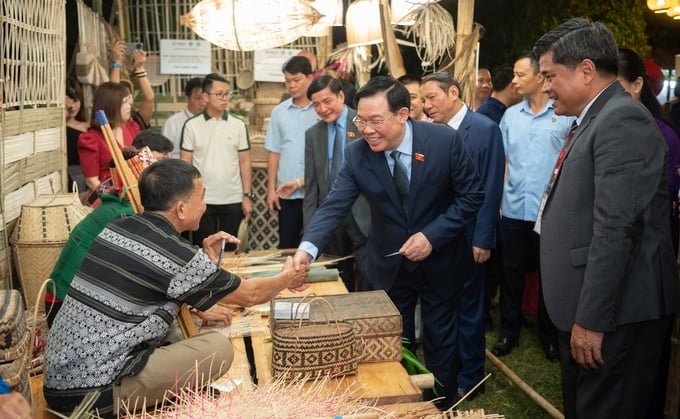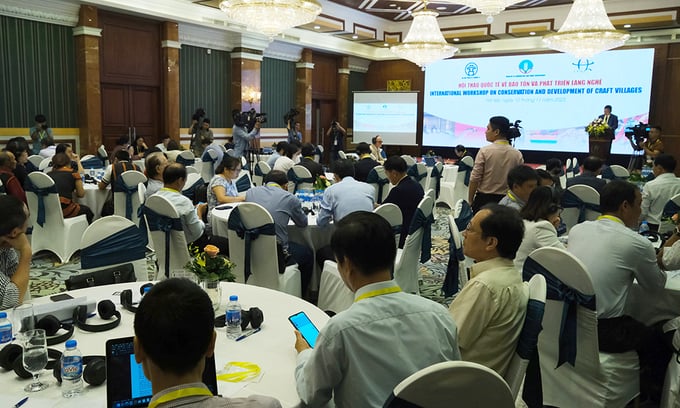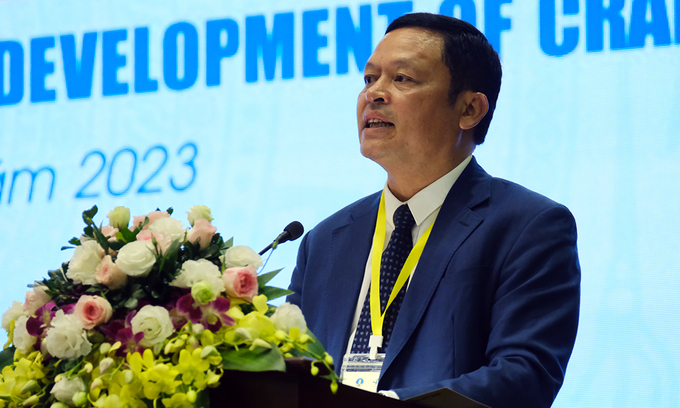December 3, 2025 | 17:09 GMT +7
December 3, 2025 | 17:09 GMT +7
Hotline: 0913.378.918
December 3, 2025 | 17:09 GMT +7
Hotline: 0913.378.918

National Assembly Chairman Vuong Dinh Hue visited booths at the Craft Village Festival. Photo: NA.
At the international workshop on the conservation and development of craft villages, Mr. Ta Van Tuong, Deputy Director of the Hanoi Department of Agriculture and Rural Development, stated that the city is the birthplace of more than 1,350 craft villages and villages with professions, encompassing 47 out of 52 traditional trades nationwide.
The region is also the hub for numerous craft villages across the country, including 69 villages in the processing and preservation of agriculture, forestry, and aquatic products; 22 villages in handmade fine arts; 197 villages in the production of wooden goods, bamboo and rattan products, ceramics, glass, textiles, fibers, lace embroidery, and small-scale mechanics; 13 villages in the production and business of ornamental animals; 16 villages in processing and processing materials for rural industry; and 5 villages in services for production and rural residents' lives.

The craft village conservation workshop had the participation of many professional agencies, local authorities and artisans. Photo: Bao Thang.
The capital currently has 303 artisans, including 13 People's Artisans and 42 outstanding artisans. In 2023, 46 profiles for recognizing the title of Hanoi Artisan are under consideration, and 38 profiles for recognizing People's Artisans and outstanding artisans have been submitted to the Central.
Tuong evaluated that the development of craft villages creates many job opportunities, not only for people of working age but also provides additional employment for the elderly, people with disabilities, and children. The development of craft villages helps increase income for the leaders, narrowing the income gap for the poor in rural areas. The development of craft villages also creates conditions to connect communities, develop cultural values, preserve traditional cultural and historical values, and pass on artistic essences from generation to generation.
Regions with craft villages have grown in terms of revenue, production value, and export value. Among them, about 100 craft villages achieved revenues from 10 to 20 billion VND per year, nearly 70 craft villages achieved revenues from 20 to 50 billion VND per year, and about 20 craft villages achieved over 50 billion VND per year.
The average income of laborers in craft villages is much higher than that of pure farmers, with the common average income ranging from 4 to 5.5 million VND per laborer per month. Different craft villages have different income levels for workers, such as the average income of workers in bamboo and rattan weaving villages reaching 11.2 million VND per person per month, sculpture fine arts villages reaching 10 million VND per month, and the white apricot village in An Hoa reaching an average income of 17 million VND per person per month.
To promote production development, enhance competitive capacity, and add value to craft village products; support the development of craft villages to create employment and increase income for people; preserve and promote the values and cultural identity of traditional craft villages, contributing to promoting economic and social development in rural areas, Hanoi has many measures to preserve, conserve, and develop traditional crafts, craft villages, and villages with professions.
In addition to participating in domestic and international fairs, weekly markets, competitions, and festivals, Tuong hopes that the workshop will provide advice on some issues for Hanoi.
These include: Advising on the construction and operation of the Creative Craft Village Design Center; Consulting on the development of craft village models, craft village routes, and typical handicraft designs of Hanoi and neighboring areas, with a focus on creative design and traditional cultural values; Coordinating to support leading craft businesses in the city to develop new designs based on the aesthetic needs of social consumption.
Hanoi's craft villages and artisans also hope to be advised on the conservation of at least one craft village, making it a model for replication. Furthermore, they aim to coordinate in developing some outstanding craft villages that meet modern criteria and expand international relations.

Mr. Ta Van Tuong hopes that organizations will coordinate to support Hanoi in developing craft villages. Photo: Bao Thang.
Mr. Kevin Murray, Vice Chairman of the World Crafts Council, shared his experience in preserving the pottery craft in Stoke-on-Trent, a city in the Midlands of the United Kingdom.
The pottery industry in Stoke-on-Trent began modestly in the mid-17th century. However, with the abundance of local coal and clay, this industry quickly developed, making the city the capital of the pottery mist land.
In 1956, traditional kilns were forced to be replaced by gas and electric kilns, leading to a significant decline in the pottery industry in Stoke-on-Trent. From having more than 300 potters in the early 20th century, the city now has only a small fraction.
To preserve this heritage, the local government has improved propaganda work for the people and introduced pottery lessons to schoolchildren from an early age. Today, people from Stoke-on-Trent are considered to have "clay in their blood."
"This is not a literal call but about life, emotions. People from Stoke-on-Trent interact with the material that has formed their city. Local people come to Stoke with pride in their city and heritage," Murray expressed.

A pottery workshop is decorated like a miniature museum in Stoke.
Based on the experience of Stoke-on-Trent, the Vice Chairman of the World Crafts Council believes that the effort to preserve craft villages should start as early as possible, focusing on artisans as the center, protagonists, and target audience.
Agreeing with Mr. Murray, Ms. Tran Thi Thu Oanh, Chief Technical Advisor of the International Development Relief Organization (FIDR) in Vietnam, said that the organization successfully implemented a project to preserve the traditional weaving craft of the Co Tu people in Quang Nam province from 2007 to 2012 on a scale of 60 households.
Building on this success, FIDR has developed community-based tourism for ethnic minority groups. Currently, since 2021, the organization has promoted rural handicrafts with 100,000 households throughout Quang Nam province.
Through the project, Oanh noted that to preserve traditional craft villages, it is necessary to attract the participation of the younger generation. This can be achieved through the operation of group activities, cooperatives, marketing services, finance, accounting, knowledge, and technology skills.
Translated by Linh Linh

(VAN) This is an initiative of MAE aimed at creating a unified coordination mechanism to implement agricultural cooperation programs with developing countries.

(VAN) Con Dao National Park officially received its Green List status after it was announced at the IUCN World Conservation Congress in Abu Dhabi in October.

(VAN) The National Assembly’s inspection delegation called for a renewed approach to marine economic development, the removal of legal 'bottlenecks,' and strengthened marine environmental protection.

(VAN) The inevitable path forward is to reorganize production along the value chain, utilizing cooperatives as the core, enterprises as the driving force, and farmers as the central subjects.

(VAN) On November 28, Minister Tran Duc Thang, together with China's Minister of Agriculture and Rural Affairs Han Jun, chaired the 2nd meeting of the Viet Nam - China Agricultural Cooperation Committee.

(VAN) Forest carbon credits are only accepted when they ensure absolute environmental integrity, additionality, permanence, and transparency.

(VAN) Viet Nam partners with Beijing on controlling air pollution, cross-regional management, high-tech monitoring and relocating polluting facilities.